|
|
|
|
|
Intel 6xx Series and 3.73GHz Extreme Edition CPUs |
|
Join the community - in the OCAU Forums!
|
Multitasking Performance and Overclocking
MULTITASKING:
The test results in this section show performance when several applications are running simultaneously. In one WorldBench benchmark test Mozilla and MS Media Encoder run in parallel. Another such test is the PCMark 2004 System Suite. It includes 9 different application subtests, 3 of them are running in pairs.
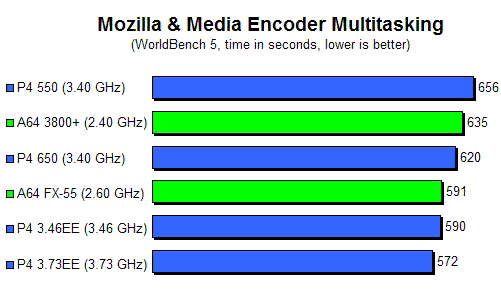
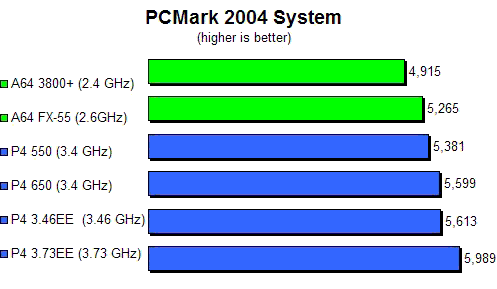
In both applications we see the 650 gaining around 5% on the 550, and the 3.73 GHz EE is taking the overall lead. The P4 seem to make good use of their hyperthreading capability in these multitasking benchmarks and in both tests the Intel processors are clearly ahead of the AMD competition.
OVERCLOCKING GALORE:
While overclocking might be regarded by some as the hobby of a small number of enthusiasts, it can indeed be more than that. High overclocking headroom indicates platform and system stability at the specified stock frequency and the remaining upward frequency potential of a processor line. The initially released Prescott core with 1 MB L2 cache is already known for its good overclocking potential. Due to Prescottís relatively high heat output it is unfortunately not possible to exploit this potential with air cooling, in particular not with stock cooling. Lower clocked Prescotts such as 520 and 530, with liquid or phase-change cooling, have been shown in some cases to run stable for benchmarking with up to 1000 MHz on top of their specified frequency.
With the 6xx series we have to consider that the Prescott core has been manufactured for some time already and is therefore yielding higher frequencies than at the beginning of the production cycle. On the other hand the 6xx series has more transistors than the 5xx series, and that is a disadvantage for overclocking due to the higher heat output. We were therefore quite curious to see how far we could take the 6xx series based processors.
We started with the Intel provided cooling solution: that is the LGA aluminum heatsink with copper core and a temperature controlled fan running at a maximum speed of around 2,200 rpm. This HSF proved to be good enough to drive both processors above 4.00 GHz. In both cases we did not have to increase the specified core voltage, the BIOS CPU voltage option was set to AUTO. We then mounted the Bigwater kit from Thermaltake, a rather cheap and easy to install entry level water cooling solution and started cranking up FSB frequency and voltage.
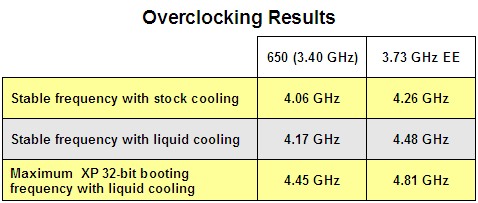
The maximum stable frequency with liquid cooling to run all our benchmarks was well above 4.00 GHz for both CPU, the 3.73 GHz EE achieved almost 4.50 GHz. These are very satisfying results, considering that both samples were running with their specified stock voltage and manufacturer provided cooling at and above 4.00 GHz. In particular the 3.73EE headroom is amazing considering that this processor is already very close to the official maximum Prescott stock frequency of 3.80 GHz. Processors at the upper end of the frequency range can usually not provide any more overclocking headroom than the lower clocked variants are usually offering. Yet it was possible to run all our benchmarks without any stability problem with the stock cooling solution, with our 3.73 at 4.25 GHz. Above 4.50 GHz the system became unstable, but even at 4.80 GHz we could still run a few benchmarks with exciting results for memory bandwidth and SuperPi calculations.
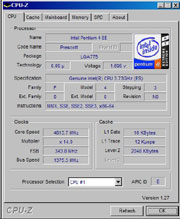 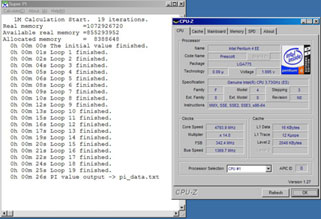
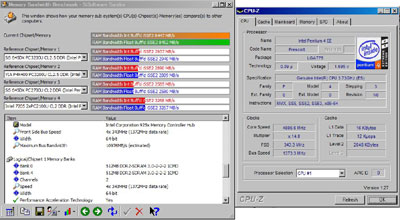
The question is, why did Intel cancel the planned 4.00 GHz Pentium 4 when they obviously have processor samples that can run at this frequency? Of course, manufacturers like AMD and Intel are applying more stringent stability tests and requirements than we do in a review like this. Yet, looking at our results there is some reason to believe that Intel would be in the position to manufacture at least a small quantity of Prescott cores that would pass extreme stability testing at 4.00 GHz. It has therefore been speculated that the reason to drop the 4.00 GHz Prescott variant is more marketing driven than being based on "exhausted" technology. Initially it was speculated that unmanageable heat output at 4.00 GHz had prevented Intel from releasing such a processor. It could be though that this decision was more related to Intelís upcoming dual core solutions. Interestingly Intel made the announcement to cancel the 4.00 GHz Prescott at the same time when they announced the planned "Smithfield" (8xx series) dual core desktop processor type due in mid 2005. It could be therefore that the single core processor line is kept below 4.00 GHz to let a probably commercially more profitable dual core 820 (2.8 GHz) look performance-wise more attractive. The 820 will have a clearer advantage when compared with a single core 670 (3.8 GHz) instead of a (hypothetical) 680 clocked at 4.00 GHz. Of course, there'ss a lot of speculation here. But fact of the matter is that both 6xx series processors in our test were stable running all the many tests we threw at them at 4.00 GHz with stock cooling and at stock voltage.
|
|
Advertisement:
All original content copyright James Rolfe.
All rights reserved. No reproduction allowed without written permission.
Interested in advertising on OCAU? Contact us for info.
|

|


